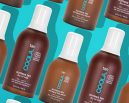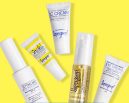Everything You Need To Know About Sunscreen

Our Customers Asked:
Sunscreen is so confusing! What do I actually need to know to protect myself? And what do I do if I’m already burned?
Our Pharmacists Answered:
Right around Memorial Day Weekend every year, sun protection becomes a hot topic amongst our customers and in the media. In reality, it should be on our minds all year long! The sun’s harmful rays reach our skin even when it’s cloudy in the winter time, in fact, it’s those times when we don’t even think to protect ourselves that the most damage is being done. Unfortunately, while care products are all available over-the-counter, sun protection is a topic that usually requires some help from a health-care professional to truly understand. That’s why we’ve gathered our team of C.O. Bigelow pharmacists to give you the most pertinent information you need to know before taking a trip to the beach this summer.
“If you remember nothing else from this article, remember to look for broad spectrum sunblock!”
First and foremost, let’s talk about why sunscreen is important. The sun doesn’t just emit light and heat, but harmful ultraviolet (UV) rays that are unable to be seen by the human eye. These UV rays are what actually causes damaging sunburns to our skin, as well as deeper damage that leads to early wrinkling, sagging, and aging. There are two kinds of UV rays: UVA and UVB. UVA rays penetrate deeply into the skin below the surface, and are primarily responsible for long term effects on our skin like the aging and wrinkling mentioned before. UVB rays have a much shorter wavelength, and therefore only penetrate superficially into the surface. These are the rays that cause sunburns and redness on the skin’s surface. It is very important to protect yourself from both types of rays, as they can both lead to skin cancer. However, as you’ll find out later on, sunscreen labels can be deceiving, and it is not so easy to find products that give protection from both UVA and UVB.
So now we know about UVA and UVB, but what about the other commonly heard abbreviation, SPF? “Sun Protection Factor” is the number one factor most people use in order to determine which sun protection product to purchase. It is also the number one most misunderstood term by people looking for sun protection! SPF measures a product’s ability to prevent UVB rays only from damaging skin, but has no relation to UVA damage. The actual number (SPF 15, 30, 45, etc…) represents the amount of time you are able to stay in the sun without burning as it relates to that same amount of time without using any sun protection. So, in simpler terms, if you can normally last 10 minutes in the sun without your skin turning red, using sunblock with SPF 15 will allow you to spend 150 minutes (10 minutes x SPF 15) in the sun without burning. This is an ideal case if you apply the correct amount of sunscreen and you apply it at least 30-60 minutes prior to exposure to the sun. Most people don’t apply enough, spray a little bit and then head immediately outside or apply it once they’re already at the beach!
Ok, if SPF only tells us how well we are protected from UVB rays, how do we know about UVA protection? Sunblock that provides UVA protection will be labeled as “broad spectrum.” If you remember nothing else from this article, remember to look for broad spectrum sunblock! Here at C.O. Bigelow, our pharmacists recommend the brands COOLA and SUPERGOOP, as they have broad spectrum coverage and strong water-resistance. As far as which SPF to go for, 30 is the best “bang for your buck.” SPF 30 sunscreen blocks 97% of UV rays, while SPF 50 only improves that coverage to 98%. Don’t fall victim to propaganda convincing you that SPF 70 is necessary to prevent cancer. Any product SPF 30 and above will provide just about the same protection. Again, just make sure it has broad spectrum coverage and make sure you apply the right amount 30-60 minutes before sun exposure!
Sometimes even the most vigilant sun protectors wind up burned at the end of a long day. Applying sunblock every 90 minutes or so can be an arduous task, especially if you’re responsible for protecting an active child! A sunburn at it’s core is really just an increase in inflammation to the skin’s surface. UV rays damage the surface cells, and the body increases blood flow to those areas to speed up recovery. This increased blood flow is why your skin turns red. This is also why your skin turns white when you press on a sunburn, as you force blood flow away for a couple seconds, and skin returns to red as you remove the pressure and allow blood to flow back to the area. Keeping this in mind, the best sunburn treatment will reduce inflammation and help the skin return to form. Our pharmacists recommend taking an anti-inflammatory drug like ibuprofen, as well as icing wherever tolerable for short periods of time, in order to reduce that surface inflammation. It’s also important to drink lots of water and use a moisturizer to keep the skin from drying out. Finally, if ibuprofen isn’t adequately controlling pain, Aloe Vera can be used to soothe the skin. Follow these guidelines and your burn should be gone within 4-7 days.
There is plenty more to talk about when it comes to protecting yourself from the sun, but we don’t want to drown out the most important facts with less important information. This is the info our pharmacists make sure to relay to any patient of ours who asks about sun protection. If you are in need of answers you don’t see here, our pharmacists are available 7 days a week, 365 days a year, at 212-533-2700. For now, you should feel comfortable wandering the aisles of your local drug store and picking a great sunblock product armed with the right information. Just remember: broad spectrum, water-resistant, SPF 30+! Enjoy the sun this summer (and always)!


BRANDS MENTIONED IN THIS POST
Deprecated: Function related_posts is deprecated since version 5.12.0! Use yarpp_related instead. in /var/www/html/magento2-bigelowchemists/public/blog/wp-includes/functions.php on line 5383


